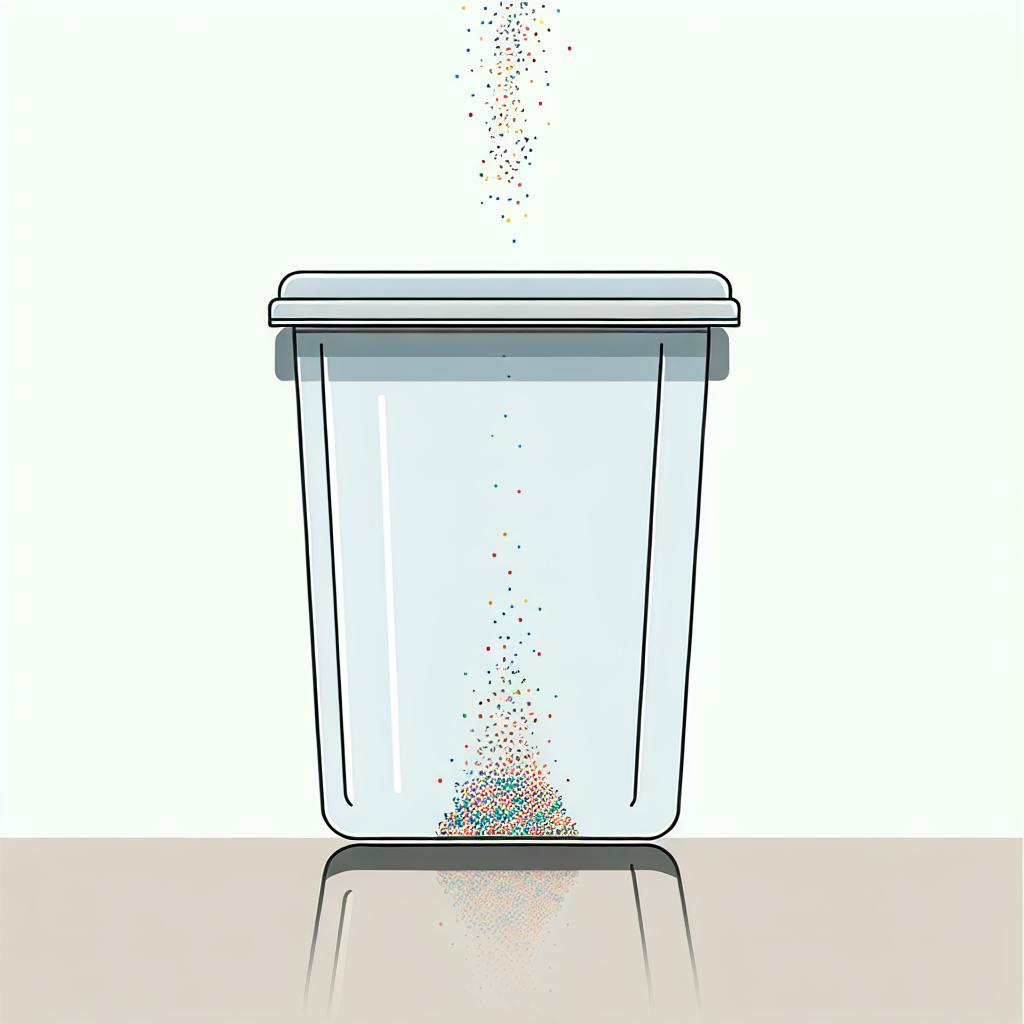Microplastics are tiny plastic particles that pollute our environment, harming marine life and entering the food chain. A microplastic citizen science project empowers you to take action by collecting data, raising awareness, and driving community-led solutions.
Key Steps:
-
Define Goals: Identify the specific issues you want to address, what you aim to learn, and the impact you want to make.
-
Choose Data Collection Methods: Select techniques like visual surveys, sampling, sieving, or microscopy based on your resources and required precision.
-
Build a Volunteer Team: Recruit passionate volunteers, provide comprehensive training, and foster a sense of community.
-
Collect High-Quality Data: Develop a standardized sampling protocol, document everything, and store samples properly.
-
Ensure Data Quality: Implement quality control measures, provide thorough training, and regularly validate data.
-
Manage Logistics and Funding: Create a detailed project plan, secure funding, and build partnerships.
-
Keep Volunteers Engaged: Offer skill development opportunities, provide updates, and recognize contributions.
-
Share Results: Report findings, inform environmental policies, and encourage community-driven solutions.
By following these steps, your citizen science project can contribute to a better understanding and mitigation of microplastic pollution, fostering a more informed, engaged, and sustainable society.
Quick Comparison: Data Collection Methods
| Method | Description |
|---|---|
| Visual Surveys | Observing and counting microplastics in the environment |
| Sampling | Collecting water or sediment samples for laboratory analysis |
| Sieving | Using mesh sieves to separate microplastics from other materials |
| Microscopy | Using microscopes to examine and identify microplastics |
Setting Up Your Project
Defining Your Goals
Before starting your microplastic citizen science project, define your goals and expected outcomes. What do you want to achieve? What questions do you want to answer? What impact do you want to make? Clearly defining your goals will help you focus your efforts, allocate resources, and measure the success of your project.
Consider the following questions to help you define your goals:
- What specific problem do you want to address? (e.g., microplastic pollution in a local waterbody)
- What do you want to learn or discover through your project? (e.g., the types and amounts of microplastics present)
- What actions do you want to inspire or inform through your project? (e.g., policy changes, behavioral changes, or community engagement)
Choosing Data Collection Methods
Select reliable techniques for gathering microplastic data. You'll need to consider:
- The type of microplastics you want to study (e.g., fibers, fragments, microbeads)
- The location and accessibility of your sampling sites
- The resources and equipment available to you (e.g., sieves, microscopes, sampling gear)
- The level of precision and accuracy required for your project
Some common data collection methods for microplastic studies include:
| Method | Description |
|---|---|
| Visual surveys | Observing and counting microplastics in the environment |
| Sampling | Collecting water or sediment samples for laboratory analysis |
| Sieving | Using mesh sieves to separate microplastics from other materials |
| Microscopy | Using microscopes to examine and identify microplastics |
Planning Data Analysis
Develop a strategy for analyzing and interpreting the collected data. You'll need to consider:
- The types of data you'll be collecting (e.g., qualitative, quantitative, categorical)
- The statistical methods and tools you'll use to analyze the data
- The ways in which you'll present and visualize the data
A well-planned data analysis strategy will help you:
- Identify patterns and trends in the data
- Draw meaningful conclusions about the microplastic pollution in your study area
- Inform decision-making and policy development
- Communicate your findings effectively to stakeholders and the broader public
Building Your Volunteer Team
Building a team of dedicated volunteers is crucial to the success of your microplastic citizen science project. Volunteers will help you collect data, conduct research, and spread awareness about the issue of microplastic pollution. In this section, we'll discuss how to recruit and retain volunteers, as well as provide them with the necessary training and resources.
Recruiting and Retaining Volunteers
To build a strong team of volunteers, follow these steps:
- Identify your target audience: Who is most likely to be interested in your project? (e.g., environmentalists, students, community groups)
- Use social media: Spread the word about your project on social media platforms
- Partner with local organizations: Collaborate with local universities, community groups, or environmental organizations to reach a wider audience
- Offer incentives: Provide training or certification to encourage volunteers to participate and stay engaged
- Create a sense of community: Host events, provide opportunities for socialization, and recognize volunteers' contributions to foster a sense of community
Training Volunteers
To ensure volunteers collect high-quality data and conduct effective research, provide them with the necessary training and resources:
| Training Component | Description |
|---|---|
| Comprehensive training program | Cover the basics of microplastic research, data collection methods, and safety protocols |
| Educational resources | Offer online tutorials, workshops, or field guides to help volunteers develop their skills and knowledge |
| Mentorship | Pair experienced volunteers with new recruits to provide guidance and support |
| Ongoing support | Provide feedback and support to volunteers to ensure they feel confident and equipped to conduct high-quality research |
By following these steps, you can build a dedicated team of volunteers who are passionate about microplastic research and committed to making a positive impact.
sbb-itb-1dc3f59
Collecting Data
Collecting data is a crucial step in your microplastic citizen science project. This section will guide you through the process of collecting high-quality data, ensuring that your project yields reliable and meaningful results.
Sampling and Surveys
To collect microplastic samples, follow these steps:
- Choose a suitable location: Select a location that is easily accessible and representative of the area you want to study.
- Use appropriate equipment: Use sieves, gloves, and other necessary equipment to collect and handle microplastic samples safely and efficiently.
- Develop a sampling protocol: Establish a standardized protocol for collecting samples, including the size and number of samples, to ensure consistency and reliability.
- Consider using a control sample: Collect a control sample from a location with minimal human impact to compare with your study site.
Data Quality and Management
To ensure the integrity of your data, follow these guidelines:
| Guideline | Description |
|---|---|
| Document everything | Keep a detailed record of your sampling protocol, including dates, locations, and any observations. |
| Use a standardized data sheet | Create a data sheet to record your findings, including the type and quantity of microplastics found. |
| Store samples properly | Store samples in a cool, dry place, away from direct sunlight, to prevent degradation. |
| Analyze samples promptly | Analyze samples as soon as possible to prevent contamination or degradation. |
By following these guidelines, you'll be able to collect high-quality data that will help you understand the impact of microplastics on the environment and inform effective solutions.
Overcoming Challenges
Identifying and overcoming common obstacles encountered in citizen science projects.
Ensuring Data Quality
Approaches to maintain data quality despite differing levels of volunteer expertise.
To ensure data quality, consider the following strategies:
| Strategy | Description |
|---|---|
| Develop a comprehensive data collection protocol | Establish a clear and standardized protocol for data collection to minimize errors and inconsistencies. |
| Provide thorough training | Train volunteers on the data collection protocol, ensuring they understand the procedures and can accurately collect data. |
| Implement quality control measures | Regularly review and validate data to detect and correct errors, ensuring the data is reliable and accurate. |
Managing Logistics and Funding
Strategies for dealing with logistical issues and securing funding.
To manage logistics and funding, consider the following strategies:
| Strategy | Description |
|---|---|
| Develop a detailed project plan | Create a comprehensive plan outlining project goals, timelines, and budgets to ensure effective management of resources. |
| Secure funding | Explore various funding opportunities, such as grants, crowdfunding, and partnerships with organizations, to support project activities. |
| Build partnerships | Collaborate with local organizations, universities, and government agencies to access resources, expertise, and funding. |
Keeping Volunteers Engaged
Techniques to sustain volunteer interest and participation over time.
To keep volunteers engaged, consider the following strategies:
| Strategy | Description |
|---|---|
| Provide regular updates and feedback | Keep volunteers informed about project progress, results, and impact, ensuring they feel valued and engaged. |
| Offer opportunities for skill development | Provide training and opportunities for volunteers to develop new skills, enhancing their experience and motivation. |
| Recognize and reward volunteer contributions | Acknowledge and reward volunteer efforts, fostering a sense of appreciation and commitment to the project. |
By implementing these strategies, you can overcome common challenges in citizen science projects and ensure the success of your microplastic citizen science project.
Sharing Results and Driving Change
Reporting Findings
To effectively communicate your project's results, follow these steps:
- Write a clear and concise report that summarizes your project's objectives, methods, and results.
- Use visual aids like graphs, charts, and infographics to present complex data in an easily understandable format.
- Provide recommendations for future actions based on your project's findings.
- Share your report through various channels, including social media, project websites, and local newspapers.
Informing Environmental Policy
Citizen science data can significantly contribute to informing and shaping environmental policy. To achieve this, consider the following strategies:
| Strategy | Description |
|---|---|
| Collaborate with policymakers | Work with policymakers and government agencies to ensure your project's findings are integrated into policy decisions. |
| Provide data and insights | Offer data and insights that can inform policy development, such as identifying areas of high microplastic pollution. |
| Organize workshops and seminars | Host workshops, seminars, or conferences to present your project's findings and engage with policymakers and stakeholders. |
| Develop policy briefs | Create policy briefs or fact sheets that summarize your project's key findings and recommendations. |
Community-Driven Solutions
Encouraging community-driven solutions to microplastic pollution can lead to sustainable and effective change. To achieve this, consider the following strategies:
| Strategy | Description |
|---|---|
| Organize community events | Host community events, such as clean-up activities, to raise awareness and engage citizens in addressing microplastic pollution. |
| Collaborate with local groups | Work with local businesses, schools, and community groups to develop and implement solutions tailored to their needs. |
| Provide resources and support | Offer resources and support for community-led projects, such as funding, expertise, or access to data. |
| Foster community ownership | Involve community members in the decision-making process to foster a sense of ownership and responsibility. |
By sharing results and driving change, citizen science projects can have a significant impact on addressing microplastic pollution and promoting environmental sustainability.
Conclusion: The Impact of Citizen Science
Citizen science projects have a significant impact on our understanding and mitigation of microplastic pollution. By involving citizens in the scientific process, we can:
- Collect large-scale data
- Raise awareness about the issue
- Promote community-driven solutions
The data collected through citizen science projects can:
| Impact | Description |
|---|---|
| Inform environmental policy | Support research and policy development |
| Support research | Provide valuable data for scientists and researchers |
| Encourage individual action | Inspire individuals to take action against microplastic pollution |
The success of citizen science projects relies on collaboration, community engagement, and the willingness to share knowledge and resources. By working together, we can create a collective impact that surpasses individual efforts.
By empowering citizens to take an active role in addressing environmental issues, we can create a more informed, engaged, and sustainable society. The impact of citizen science extends beyond the scientific community, influencing policy, education, and individual behavior.
As we move forward, it is crucial to continue supporting and promoting citizen science initiatives, ensuring that everyone has the opportunity to contribute to a better understanding and mitigation of microplastic pollution.


